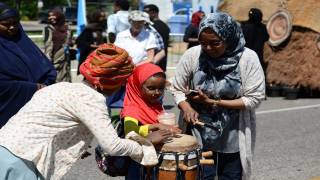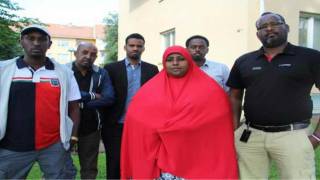Minnesota: Still Trying to Prevent Somali Jihad with Expensive Social Programs
Above, four Somalis out of six who were arrested in Minnesota in 2014 for trying to join ISIS.
How insane is a government policy that continues to import a tribe of people who resist assimilation and present a danger to the law-abiding citizens? Furthermore, that group — the Somalis — requires extensive expensive programs to keep the young male combatants from blowing up the place, and those programs don’t work. When an American filmmaker visited Minneapolis las May, he found thatmany local Muslims rejected the Constitution and would rather have head-choppy sharia law. Nevertheless, the Obama administration admits 800 Somali foreigners per month.
In 2011, I wrote Somali Immigrants in Minnesota: Import a Problem, Then Pay to Try to Fix It, focused on the Congressional testimony of the St. Paul police chief describing his taxpayer-funded outreach efforts to Somali youth. No discernible progress has been made since then.

One assimilation case was Abdullahi Mohamud Yusuf (pictured), who was nabbed at the airport on his way to join ISIS. The Minnesota-nice authorities decided to train him to“coach basketball, mentor other teens,” but a couple months later Yusuf violated his cushy terms of prison avoidance and was back in custody. Oh well!
Muslim diversity is very resistant to retraining to western culture, so it’s better to leave them in their own Islamic nations. Why welcome historic enemies inside the gates?
In the latest Somali assimilation report from Minnesota, even ultra-lib National Public Radio admits that outreach doesn’t work, but heck, more social programs are always better!
The headline says it all:
Whether It Works Or Not, U.S. Anti-Radicalization Plan Can Benefit Communities, NPR, April 3, 2016
In the ongoing investigation into the Brussels terrorist attacks, most of the attention is on one neighborhood called Molenbeek. Many of the terrorists responsible for both the attacks in Brussels, and in Paris last November, lived in Molenbeek.
The closest you can get to an analogous city in the U.S. is Minneapolis, Minn., home to the largest Somali community in the country. One in 4 of the more than 250 Americans who have tried to join ISIS are from Minnesota.
Now, the federal government is stepping in to stop this trend. The Department of Justice is giving money to local community groups in effort to create alternative paths for young people who might be vulnerable to the ISIS message.
This week on For the Record: How one community is taking on the Islamic State.
Both Mohamud Noor and Mohamed Mohamud have dedicated their lives to fixing this problem.
Noor is executive director of the Confederation of Somali Community in Minnesota; Mohamud is executive director of the state’s Somali American Parent Association.
History Of Radicalization As Mohamud Noor explains, youth recruitment to radical groups didn’t start with ISIS. “It started with al-Shabab way back almost nine years ago.”
Al-Shabab is the radical Islamist group that’s been embroiled in the long civil war in Somalia. In 2006 and 2007, more than 20 people from Minnesota left to fight with al-Shabab in Somalia.
“I think that was the wake-up call on that issue,” Noor says. “And I think that is the same propaganda or message that is being used, the ideology of fighting for someone else’s fight.”
The state’s history of radicalization has now been compounded by other factors. Minnesota Gov. Mark Dayton said recently that the income of an average Somali family in the state is more than 70 percent lower than the average white family’s.
Mohamed Mohamud says that’s connected to the threat of radicalism.
“When the young kid doesn’t have any work and living in that poverty and you get some evil people who are recruiting through the social media,” Mohamud says. “They say we have for you money, wife and power — a young kid who doesn’t have enough mind to think, when he hears that, he goes.”
Generation Gap A lot of these kids feel disconnected from their families, their peers. That may be pretty normal for teenagers anywhere, but Mohamud says that kind of isolation is amplified in immigrant families.
“Some time a father came to me and he said, ‘I am a Somali and I have an American kid in my home. Yes I am an American citizen, but what I mean is we don’t understand each other,’ ” Mohamud recalls. “The families who came to me say, for example, ‘My kid doesn’t talk to me. He is or she is closing his or her door immediately when they come to the house. I don’t know what they do.’ ”
Mohamud says that on the spectrum of being fully assimilated to staying rooted in their parent’s culture, the kids are “somewhere in the middle.”
The Federal Pilot Project The Obama administration has put a lot of time and energy into thinking about what they call countering violent extremism, and one of the big conclusions is that the federal government needs to invest in local communities. So there’s a new pilot program: The Justice Department is giving money to community groups in Los Angeles, Boston and Minneapolis. In Minnesota, six groups that work with Somali youth in will share $300,000 in grants.
“The whole community in my meetings really believed that with certain resources and the right programming, and partnerships with established nonprofits, that could lift up this community and help it fight terror recruiting,” says Andrew Luger, the U.S. Attorney for Minnesota.
Mohamud Noor and Mohamed Mohamud both run organizations that got these federal grants. And they’re tackling the issues from two perspectives: focusing on the kids, as well as their parents. One challenge they’re attacking is technology. Parents don’t understand it, which poses a problem because it can also be a place where kids are targeted by ISIS.
Mohamed Mohamud works on teaching parents the basics.
“We are trying to teach them how they can go to their laptop and see which sites they have visited.”
It’s worth pointing out how close knit this community is. Mohamud Noor knows some of the families whose kids have left to try to fight with ISIS. And he’s gotten those phone calls.
“We haven’t seen anybody leave and come back,” Noor says. “Once you leave, you’re gone for good. I know some of the parents have tried to reach out when they had that communication line open. But what we know: It’s a one way ticket.”
This whole thing may sound overly simplistic. Even the name of the program “Building Community Resilience” sounds like thousands of other social programs around the country. And, frankly, the aims are the same as many other organizations: job training, after school programs. But Andrew Luger says if there’s even a chance that this program could deter one young person, then it’s a worthy investment.
“We had to try something that would at least help the community. If it helps lessen terror recruiting, obviously that was the goal, but if it didn’t, it was still good for an important and vital part of the overall Twin Cities community,” Luger says.
Community groups in Minneapolis, Los Angeles and Boston are at different stages of putting their grant money to work.
It’s going to be impossible to determine if these programs actually end up preventing someone from going off to fight with ISIS. But those who support the program say if they end up making a positive difference in these communities, these kinds of investments could be a model that other cities will follow






















